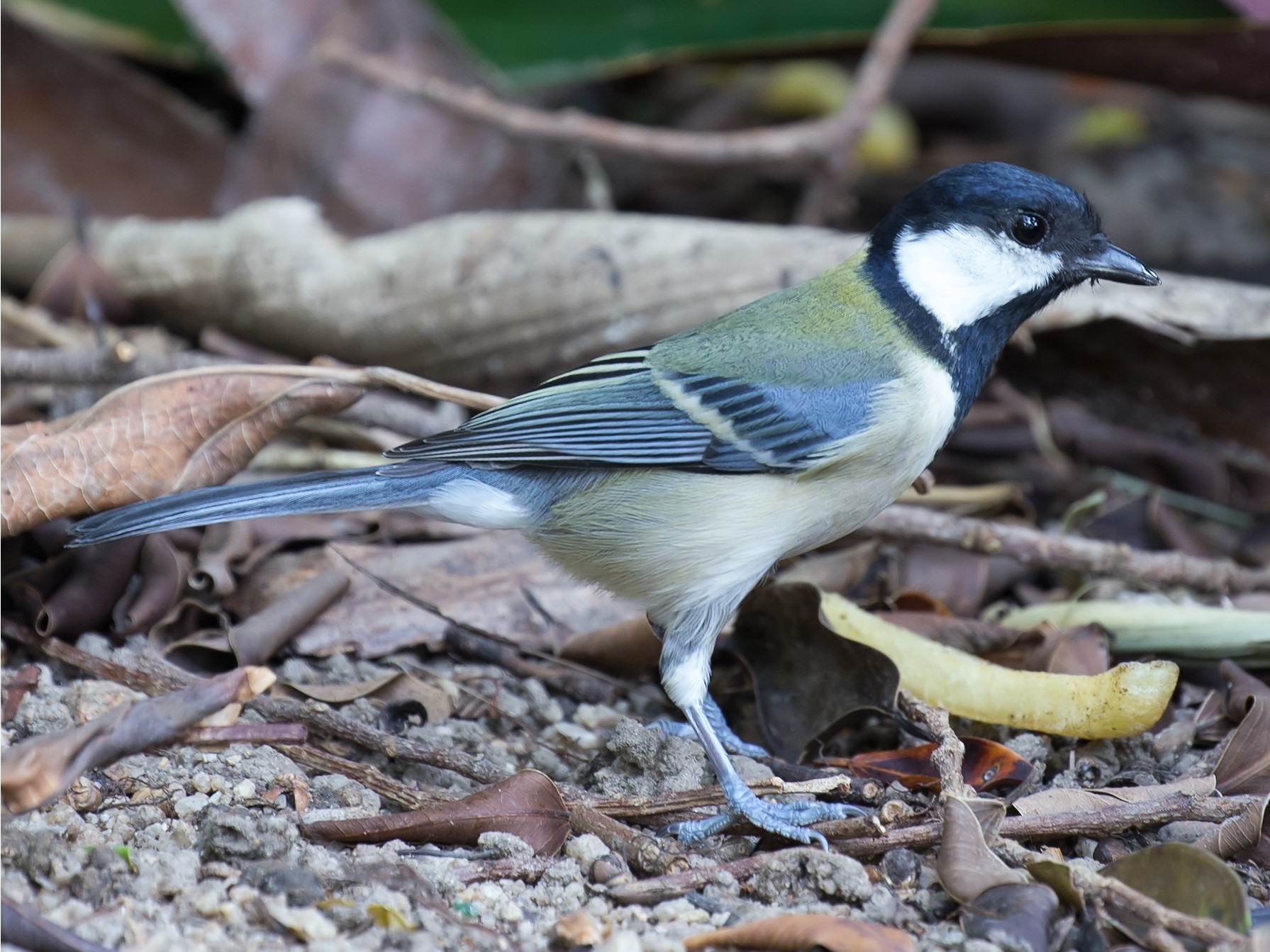Japanese Tit Parus minor 遠東山雀
Category I. Abundant resident in diverse wooded and lightly-wooded habitats.
IDENTIFICATION

Nov. 2010, Michelle and Peter Wong. Male.
12-14 cm. Black head, apart from large white cheek patch and hind neck distinctive. Black covers entire throat and extends down centre of underbody, which is otherwise pale dull greyish-white. Upperparts of the commonly occurring P. m. commixtus are generally dull slightly bluish-grey, while the greater coverts are broadly tipped white forming a striking wing bar. Males have extensive black between the legs.

Jan. 2018, Allen Chan. Presumed P. m. minor.
Rarely birds occur that have greenish in the upper mantle and a bluish tinge to the median coverts and edges to the remiges and rectrices; these are considered to be the nominate taxon P. m. minor.

May 2023, Martin Williams. Juvenile.
Noisy family parties are a feature of woodland in early summer. Juveniles have a similar plumage pattern to adults but are tinged olive above and yellowish below and usually have an obvious pale gape.
VOCALISATIONS
Song can be heard all year round but mainly in the first half of the year. Birds in urban and south-facing areas of open woodland sing earlier in the year, while milder winters encourage earlier song in all habitats. Broadly speaking two song variants are uttered. Both are a series of repeated pairs of notes that may last up to 30 seconds, one element lower in pitch, the second higher.
Also has a diverse array of other vocalisations including the following.
DISTRIBUTION & HABITAT PREFERENCE
Japanese Tit is one of the most conspicuous and characteristic species of wooded areas at all altitudes in HK. Highest densities probably occur in secondary broadleaf forest, but it is also present in pine woodland, fung shui woods, plantation woodland and small groups of trees in agricultural areas. Japanese Tits are common in wooded areas on the urban fringe on HK Island, but are only patchily distributed in urban parks and, as its absence from much of Kowloon suggests, this is not really a city bird in HK. Outside the breeding season, Japanese Tits are often present in mixed species flocks in shrubland and even reed marsh, but it only occurs marginally in mangroves.
During the 1993-96 breeding bird atlas it was recorded in 37% of squares; this increased to 47% during the 2016-19 survey, indicating range expansion presumably in tandem with the increase in forested areas. An increase was also noted in winter atlas surveys from 47% in 2001-05 to 54% in 2016-19, no doubt for the same reason.
On Lantau, Chalmers (1986) stated that there were few records, but it is now widespread. Colonisation of Cheung Chau is even more recent: there were single winter records in 1979 and 1989, but it was not noted regularly until 1994, with breeding confirmed from 1995. On Lamma there was a winter record in 1981, but it was not recorded there again until the 2001-05 winter atlas, though it remains scarce. It was recorded on Crooked Island and Tung Ping Chau during the breeding bird and winter atlas surveys of 2016-19, but not on remoter islands such as Sha Chau or the Sokos. On Po Toi it is of irregular occurrence. Breeding has been confirmed there once, while records of juveniles from late May to mid-August may indicate post-juvenile dispersal to the island.
OCCURRENCE
Japanese Tit has been considered common in HK since the earliest documented records (Swinhoe 1861). However, the only known changes in range relate to certain islands, where there has been some expansion.
Winter records on offshore islands demonstrate that some movements occur, but there is no evidence that the locally-breeding P. m. commixtus does more than undertake short-range dispersal after the breeding season; indeed, the slow pace of colonisation of the islands suggests that it is rather sedentary.
A very small number of birds showing characters of P. m. minor have been recorded, mainly in the New Territories but also in urban Kowloon and HK Island from 30 September to 20 March. There is some suggestion that these occur in response to cold weather, indicating movement by northerly populations may be more common.
BEHAVIOUR, FORAGING & DIET
Active and vocal member of the forest avifauna, where it is often the dominant small passerine of mixed winter flocks. Forages on a wide variety of seeds, fruit and invertebrates.
BREEDING
Calling juveniles are an obvious feature of spring and early summer woodlands. Herklots (1953) stated that it is double-brooded and that the breeding season in HK extends from the end of February to May. Nests or birds carrying nesting material have been noted from 10 March to 8 May. Dependant juveniles have been noted from 30 March to 10 July and on 2 September.
RANGE & SYSTEMATICS
Largely resident in Japan, Korea and in China away from the desert and plateau areas of the west and north, into north and east Indochina (Gosler et al. 2020, Liu and Chen 2020).
Polytypic, with the subspecies occurring in south China (including HK) and north Vietnam being P. m. commixtus. Of the remaining taxa, the nearest mainland forms are the nominate, which occurs to the north of commixtus as far as east Siberia, and tibetanus, which occurs in southeast Tibet and southwest China to north Myanmar.
CONSERVATION STATUS
IUCN: Least Concern. Population trend increasing. Included with Great Tit P. major.
Gosler, A., P. Clement, and D. A. Christie (2020). Japanese Tit (Parus minor), version 1.0. In Birds of the World (S. M. Billerman, B. K. Keeney, P. G. Rodewald, and T. S. Schulenberg, Editors). Cornell Lab of Ornithology, Ithaca, NY, USA. https://doi.org/10.2173/bow.gretit4.01
Liu, Y. and Y. H. Chen (eds) (2020). The CNG Field Guide to the Birds of China (in Chinese). Hunan Science and Technology Publication House, Changsha.
Swinhoe, R. (1861). Notes on the ornithology of Hong Kong, Macao and Canton, made during the latter end of February, March, April and the beginning of May 1860. Ibis 1861: 23-57.

